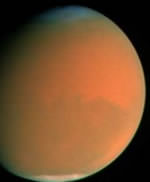
Image credit: Hubble
Now that Mars is closer than ever, amateur astronomers with regular backyard telescopes can see incredible details on the planet’s surface. On July 1, astronomers were able to see a dust storm in the Hellas Basin; four days later it was 1,800 kilometres wide, obscuring nearly a quarter of the planet. Two years ago a similar storm grew in the same region and ended up obscuring the entire planet for months. Earth and Mars will reach their closest point in 60,000 years on August 27, 2003, and the Red Planet should offer up some tremendous views.
Something is happening on Mars and it’s so big you can see it through an ordinary backyard telescope.
On July 1st a bright dust cloud spilled out of Hellas Basin, a giant impact crater on Mars’ southern hemisphere. The cloud quickly spread and by the Fourth of July was 1100 miles wide–about one-fourth the diameter of Mars itself.
“The cloud can be seen now through a telescope as small as 6 inches,” says Donald Parker, executive director of the Association of Lunar and Planetary Observers (ALPO). “Its core is quite bright.”
Parker has been tracking the cloud through his own 16-inch telescope. “A red filter helps,” he notes. “Even a piece of red or orange gelatin held between the eye and ocular will improve the visibility of the dust.”
Two years ago, a similar cloud from Hellas Basin grew until it circled the entire planet. Features on Mars long familiar to amateur astronomers–the dark volcanic terrain of Syrtis Major, for example–were hidden for months. “The planet looked like an orange billiard ball,” recalls Parker.
Will it happen again?
“No one knows,” says astronomer James Bell of Cornell University who studied the dust storm of 2001 using the Hubble telescope. “We don’t yet understand the mechanism that causes regional clouds to self-assemble into giant dust storms.”
Mars Global Surveyor and Mars Odyssey, two NASA spacecraft circling Mars, have seen many “regional storms” like the cloud near Hellas Basin now. They persist for a few days or weeks, then dissipate. Rarely do they become a planet-wide event.
“Only 10 global or planet-encircling dust storms have been reported since 1877,” notes Parker.
All dust storms on Mars, no matter what size, are powered by sunshine. Solar heating warms the martian atmosphere and causes the air to move, lifting dust off the ground.
Because the martian atmosphere is thin–about 1% as dense as Earth’s at sea level–only the smallest dust grains hang in the air. “Airborne dust on Mars is about as fine as cigarette smoke,” says Bell. These fine grains reflect 20% to 25% of the sunlight that hits them; that’s why the clouds look bright. (For comparison, the reflectivity of typical martian terrain is 10% to 15%.)
Sunlight on Mars is about to become unusually intense. The planet goes around the sun in a 9%-elliptical orbit with one end 40 million km closer to the sun than the other. Mars reaches perihelion–its closest approach to the sun–on August 30th. During the weeks around perihelion, sunlight striking Mars will be 20% more intense than the annual average.
“This means the season for dust storms is just beginning,” says Bell.
A total of four spacecraft from NASA, the European Space Agency and Japan are en route to Mars now. They include three landers and two orbiters. Will dust storms cause problems for those missions?
Probably not. NASA spacecraft have encountered Mars dust before. The Viking landers of 1976, for instance, weathered two big dust storms without being damaged. As far as researchers were concerned, it was a good opportunity to study such storms from the inside–something Mars colonists may do again one day for themselves. Viking data will give them a head start.
Five years earlier, in 1971, the Mariner 9 spacecraft reached Mars during the biggest dust storm ever recorded. The planet was completely obscured; not even the polar caps were visible. Mission controllers simply waited a few weeks for the storm to subside. Then they carried on with Mariner 9’s mission: to photograph the entire surface of the planet. It was a complete success.
As 2003 unfolds, Earth and Mars are drawing together for their closest approach in some 60,000 years on August 27th. Already in July Mars is a pleasing sight. Step outside before dawn anytime this month. Mars will be there in the southern sky, a remarkably bright red star. (If you live in the southern hemisphere, look northeast instead.)
Right: John Nemy and Carol Legate took this recent picture of bright Mars and a meteor above their campsite on Blackcomb Mountain, Whistler, British Columbia.
Even a small telescope will reveal the planet’s orange disk and its icy south polar cap. And if “seeing is good” you might catch a glimpse of some dust clouds. Swirling, surging, merging with others … building the next global dust storm? “They’re fun to watch,” says Parker. Now is a great time to see for yourself.
Original Source: NASA Science Story
